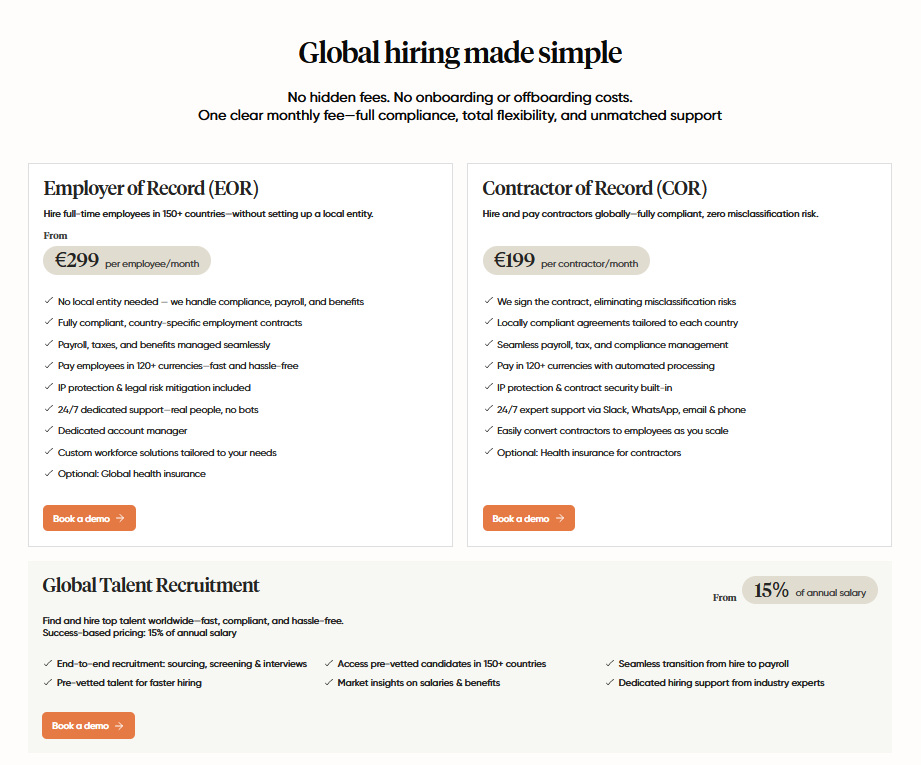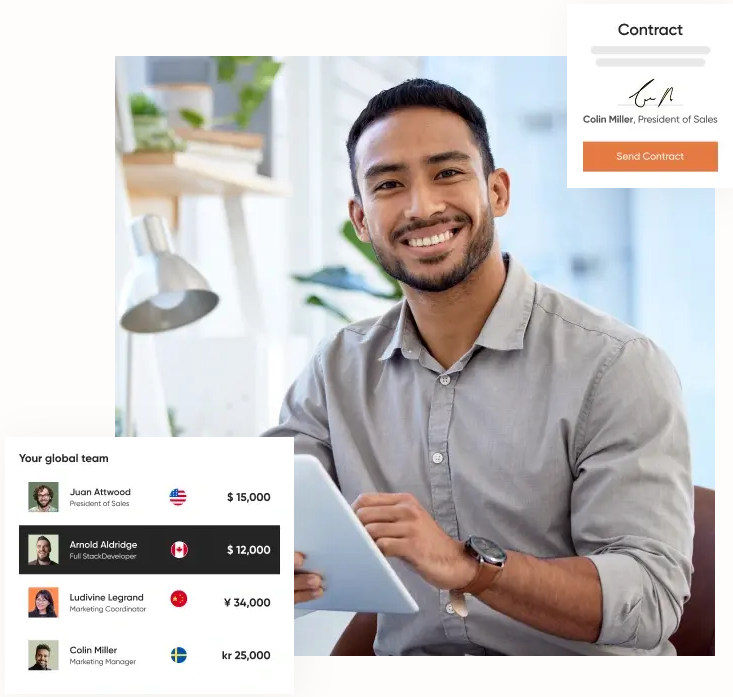
International Employment Laws
2025 Guide: Work Permits and Work Visas in Poland
Interested in working in Poland, or moving your whole team there? Here is what you need to know about work permits and visas for Poland.
Lucas Botzen
International Recruitment
13 mins read



Our Employer of Record (EOR) solution makes it easy to hire, pay, and manage global employees.
Book a demo| TL;DR Switching EOR providers is necessary when your current partner causes compliance risks, lacks transparency, or creates operational inefficiencies. Key factors when choosing a new EOR: Strong global compliance expertise Transparent, predictable pricing without hidden fees Local expertise with global reach (150+ countries for Rivermate) Seamless employee experience and ongoing support Flexibility and customization for business growth Common challenges in switching include compliance gaps, data migration risks, employee morale issues, contract transfers, operational delays, and hidden costs. A step-by-step transition plan covers: evaluating providers, defining stakeholder roles, developing a transfer strategy, setting a timeline, managing benefit changes, communicating with employees, collecting feedback, and onboarding with the new EOR. Rivermate differentiates with: Transparent pricing and predictable costs Human-first support (Slack/WhatsApp access, dedicated managers) Global compliance experts across 150+ countries Secure data transfers that meet GDPR standards Fast onboarding—employees can be set up in as little as 48 hours. |
|---|
Switching your employer of record (EOR) provider isn’t just a back-office change; it’s a strategic decision that determines how efficiently and compliantly you can scale your global team. Many companies realize too late that their current EOR has become a bottleneck: from hidden fees and slow onboarding to missed compliance updates and rigid processes.
At Rivermate, we’ve seen dozens of growing companies outgrow legacy EOR providers because of opaque pricing, outdated systems, and compliance risks. Drawing from that experience, this guide breaks down how to switch EOR providers—with a step-by-step transition plan to ensure zero disruption to payroll, benefits, or employee morale.
When evaluating EOR providers, consider these key factors that align with your company's needs, future growth, and the experience you want to deliver to your employees.
Compliance is at the heart of any EOR service. One of the main reasons companies seek an EOR is to ensure that they are adhering to local labor laws, tax regulations, and employment standards in every country they operate in. Work with an EOR provider who has deep expertise in managing international compliance.
Many companies run into trouble with EOR providers because of unclear pricing structures. Your EOR should have transparent pricing with no hidden fees. This helps you budget accurately and avoid surprises.
To avoid last-minute surprises about pricing, look for the following:
 Caption: Rivermate offers a transparent pricing model that is easy to predict
Caption: Rivermate offers a transparent pricing model that is easy to predict
Predictable costs: Especially when you are hiring international employees, you need a clear understanding of the cost per employee, including how pricing may change as you expand into new countries.
Clear cost breakdown: Ensure that the provider breaks down costs for things like employee salaries, benefits, taxes, and any additional services.
As you expand internationally, you’ll need an EOR provider that has a broad global footprint and strong local expertise in each country where you want to hire people, and have the ability to navigate complex legal machinery and compliance requirements.
An EOR should be able to handle the complexities of each market, especially assist in navigating local employment laws, accessing local networks, and understanding cultural nuances.
When it comes to global reach, Rivermate has local employment and taxation experts across 150+ countries. You will have no trouble finding, recruiting, and retaining global talent with complete compliance.
 Caption: Rivermate is a global EOR service provider with coverage in 150+ countries
Caption: Rivermate is a global EOR service provider with coverage in 150+ countries
You should provide a seamless, positive experience during the EOR transition, as it plays a critical role in the success of your business~~.~~ This includes smooth onboarding, ongoing support, and quick issue resolution.
Look for a provider that offers flexibility and customization to meet your unique business needs. This typically requires customizable workflows, easy scalability, and integrations with your existing tech stack.
A well-rounded EOR platform can provide more than just payroll. It can streamline processes, improve efficiencies, and foster a compliant, growth-friendly environment.
If your current EOR is not meeting your expectations, it is time to move. But, there are challenges in making an EOR switch.
The main challenges when switching an EOR include addressing compliance gaps across countries and states, handling data migration risks, managing employee morale, transferring contacts and preparing for unexpected expenses.
Compliance is often the number one concern when switching EOR providers, particularly in a global context. Each country has its own set of labor laws, tax regulations, and employment contracts.
Transitioning employees from one EOR to another requires a thorough understanding of these laws to avoid gaps in compliance. A delay or oversight can result in penalties, fines, or potential legal disputes.
| Say, a Brazilian tech company is planning to switch EOR providers for 50 of its employees. According to Brazilian labor laws, a 13th month salary is to be provided to employees in two instalments. If during the EOR switch, the 13th month salary is defaulted, the employer would be liable to pay penalties in addition to the accrued 13th month salary itself. |
|---|
Data security and privacy are paramount when transferring sensitive employee information such as payroll data, contracts, and tax records. Mishandling of such crucial data during the transition can lead to breaches of confidentiality, data loss, or violations of privacy regulations like GDPR, as UKG experienced in 2021.
Moreover, data migration from one platform to another can sometimes cause temporary gaps or inconsistencies, disrupting payroll processing and employee services.
Employee experience can often be overlooked during the EOR transition, yet it plays a critical role in maintaining retention and satisfaction. Employees may feel uncertain about the change, especially if the process affects their payroll, benefits, or work contracts.
Without clear communication, employees may also experience confusion or frustration, leading to disengagement or dissatisfaction.
IT Svit faced the challenge of retaining one of its employees who was moving to Canada. With Rivermate’s EOR support, they were able to retain the talent and also provide clear steps to continue the employment even with a relocation.
When you switch EOR provider, contracts with local partners, contractors, or service providers need to be properly transferred to the new EOR. This includes ensuring that all employment agreements, tax filings, benefits plans, and other legal contracts are properly updated or renegotiated. Any lapse in contract transfers can result in payroll delays, mismatched contract terms, compliance breaches, employee disputes and subsequent legal penalties, additional overhead costs, etc.
Boloo, an e-commerce company also faced the same challenge when it wanted to handle the relocation of one of its key employees. With Rivermate, they were able to quickly complete the international employment process with minimal administrative costs.
Switching an EOR provider involves significant operational changes, including system updates, new workflows, and changes in payroll processing.
Without careful planning, these operational shifts can lead to delays in payroll, disjointed workflows, and disruptions in employee services. This can lead to frustration from both employees and HR teams, particularly if deadlines or deliverables are missed.
Switching EOR providers has financial costs in terms of switching fees and unexpected hidden charges for data migration, compliance checks, or integration with other systems. If not carefully managed, these costs can add up, resulting in a more expensive transition than initially anticipated.
By understanding these challenges upfront and working with a partner like Rivermate, you can navigate the complexities of switching EOR providers with confidence.
Switching an EOR provider doesn’t have to be a stressful or disruptive process if you follow a clear, structured approach.
But, it requires careful planning and execution to ensure a seamless transition for your global workforce. Follow these key steps to manage the switch effectively and avoid disruptions:
Before making the transition, choose a new EOR provider that aligns with your company’s needs. Ensure that the new provider has extensive experience in international hiring and can accommodate your unique requirements, such as compliance, payroll, benefits, and HR tools.
Take into key consideration like:
To avoid confusion during the transition, identify and assign roles to key team members across departments. A well-coordinated team ensures that each aspect of the switch is handled smoothly.
Here’s what each department is supposed to do during the switching process:
| Department | Responsibility |
|---|---|
| HR | Manage communication with employees, oversee contract renewals, and explain new employment conditions. |
| Finance | Handle invoicing, validate the pricing structure for payroll and benefits. |
| IT | Ensure data security, set up access for the new platform. |
| Legal | Confirm compliance with local laws, review termination and transfer procedures. |
Table caption: Stakeholder responsibilities in EOR transition
A comprehensive transfer strategy is essential for a smooth transition from the previous EOR to the new EOR. Gather all necessary information from your current EOR to ensure you don’t miss any key details. This should include employee records, payroll information, benefits terms, and other legal documents.
Take into account critical strategy elements like:
Timing is critical when switching EORs. Establish a timeline that factors in notice periods and any required steps for contract termination with the current provider. Make sure everyone involved knows the deadlines to ensure a smooth process.
Timeline considerations:
Switching EORs often involves adjustments to employee benefits. Be transparent and proactive about any changes to benefits, such as PTO balances, health insurance, and retirement plans. This helps manage employee expectations and ensures satisfaction during the transition.
Employee communication:
Throughout the transition process, maintain open communication channels with your employees. Gather feedback to ensure their concerns are addressed and adjust the timeline or strategy if needed to address these concerns before the transition can be rolled completely.
Set in place these feedback channels to ease communication of concerns:
With the groundwork in place, begin the onboarding process with your new EOR provider. This involves drafting new employment contracts, setting up payroll and benefits systems, and providing employees with a detailed overview of their new employment terms.
Onboarding steps:
By now, you know what to look for in an EOR partner: compliance expertise, transparent pricing, global reach, and a great employee experience. But execution is where most providers fall short. That’s where Rivermate stands apart.
Rivermate helps global companies transition faster and safer, without disrupting employees or operations.
How Rivermate solves the biggest EOR switching challenges:
With Rivermate, you will experience a faster, smoother, and efficient way of hiring and managing your international employees.
Ready to make the switch?
Book a free 30-minute consultation with a Rivermate expert today.
You will need to review your contract terms with your current provider to understand any exit clauses, notice periods, and obligations. Working with your new EOR provider can help manage the transition smoothly.
Once the agreement is signed, the focus shifts to transferring contracts, data migration, and onboarding employees under the new provider. The new EOR will guide you through each step to ensure compliance.
Clear communication and transparency are key. Explain the process in detail, reassure employees that their benefits and compensation will be unaffected, and provide ongoing support during the transition.
The timeline varies depending on the complexity of the transition. On average, it takes about 4-6 weeks, but working with a provider like Rivermate can expedite the process.
It depends on local regulations and the specific nature of the roles. Your new EOR will assist in determining any legal requirements for employee training or health checks based on the country of employment.
What is the best way to switch EOR providers without disrupting payroll?
Start by choosing an EOR that offers dedicated transition support, in-country compliance experts, and secure data migration. Rivermate handles contract transfers, payroll continuity, and employee onboarding across 150+ countries with zero downtime.

Lucas Botzen is the founder of Rivermate, a global HR platform specializing in international payroll, compliance, and benefits management for remote companies. He previously co-founded and successfully exited Boloo, scaling it to over €2 million in annual revenue. Lucas is passionate about technology, automation, and remote work, advocating for innovative digital solutions that streamline global employment.


Our Employer of Record (EOR) solution makes it easy to hire, pay, and manage global employees.
Book a demo
International Employment Laws
Interested in working in Poland, or moving your whole team there? Here is what you need to know about work permits and visas for Poland.
Lucas Botzen

International Employment Laws
Want to move your team to Germany? Read on to find out all there is to know about work permits and visas in Germany.
Vladana Donevski

International Employment Laws
Want to live and work among the Dutch? Here is all you need to know about work permits and visas for the Netherlands.
Lucas Botzen